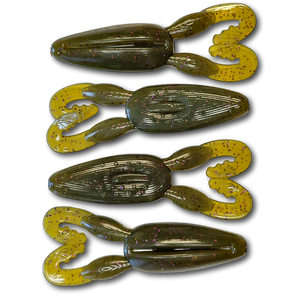Soft plastic frogs are topwater baits designed to mimic the movement and profile of real frogs or other amphibians, a prime target for predatory fish like bass. Their lifelike action, combined with their weedless design, allows anglers to fish them in heavy cover and shallow water where other lures would snag.
These baits come in a variety of styles, from hollow-bodied frogs with a soft, collapsible exterior to solid soft plastics with kicking legs or paddletails. Each type is tailored for specific conditions and presentations, but they all share one purpose: to provoke aggressive surface strikes from fish hiding in thick vegetation or ambush points.
Fishing soft plastic frogs is all about triggering reaction strikes with lifelike action. Rigging and presentation play a key role in maximizing their effectiveness.
One of the most common ways to fish frogs is weightless rigging with a wide-gap hook. This setup keeps the bait weedless, allowing it to glide across lily pads, grass mats, or other thick vegetation. The legs of the frog kick and flutter with every movement, mimicking a live frog skittering across the surface.
Hollow-bodied frogs, often paired with double hooks molded into the bait, are ideal for heavy vegetation. These frogs are typically worked with a walk-the-dog action, creating a side-to-side motion that imitates a distressed amphibian. Pausing the retrieve periodically can entice hesitant fish into striking.
For open water or sparse vegetation, weighted soft plastic frogs with kicking legs can create commotion and noise, drawing fish from deeper water. These frogs are best retrieved at a steady pace to maintain a consistent kicking action.
In addition to traditional topwater presentations, frogs can also be rigged Texas style for fishing around shallow wood cover or skipping under docks. This method allows the bait to fall into pockets or holes where bass are waiting to ambush prey.
Frogs are most effective during warm months when bass are active near the surface and frogs or other amphibians are a regular part of their diet.
- Spring: As water temperatures rise, frogs become a viable bait, especially in shallow spawning areas. Target bass near vegetation, reeds, or brush where they are protecting nests.
- Summer: This is peak frog fishing season. Bass seek shade and cooler water during the heat of the day, making grass mats, lily pads, and overhanging trees prime spots for frog presentations. Early morning and late evening are the best times to fish frogs, as bass feed more aggressively during low-light conditions.
- Fall: Frogs remain effective as bass feed heavily in preparation for winter. Focus on shallow cover, like dying vegetation or riprap, where frogs and other prey are concentrated.
Geographically, frogs excel in lakes, ponds, and rivers with abundant vegetation. Areas with lily pads, hydrilla, coontail, or other aquatic plants are perfect habitats for using frog baits. Frogs also perform well in backwater sloughs, creeks, or farm ponds where amphibians are naturally present.
Best Colors and Sizes for Frogs
Color selection depends on the conditions and local forage. Natural colors like green, brown, or white mimic real frogs and work best in clear water. For stained or murky water, brighter colors like chartreuse, yellow, or black can help fish locate your bait.
The size of your frog should match the conditions and the fish you’re targeting. Larger frogs (3.5-4 inches) are better for aggressive or larger bass, while smaller frogs (2-3 inches) are more effective in heavily pressured waters or when targeting smaller fish.
Why Frogs Are So Effective
Frogs excel because they can be fished in places other lures can’t go. Their weedless design allows anglers to target fish buried in thick vegetation or tight cover, where bass often hide and wait to ambush prey. The lifelike kicking action and commotion on the surface mimic a real frog’s natural movements, triggering both feeding and reaction strikes.
Topwater frogs also give anglers the unique advantage of visual feedback—watching a fish explode on a frog is as thrilling as fishing gets. Their ability to stay in the strike zone longer, combined with pauses during retrieval, gives bass plenty of time to commit to the bait.
Tips for Fishing Frogs
When fishing frogs, timing your hookset is critical. Bass often strike frogs violently but may not fully engulf the bait on the first hit. Waiting a moment after the strike before setting the hook ensures better hook penetration.
Use heavy braided line (40-65 lb test) for frog fishing. The strong line cuts through vegetation and provides the power needed to pull big bass out of thick cover. Pair your setup with a medium-heavy or heavy rod with a fast action tip for maximum control.
Experiment with retrieve speeds and pauses to match the mood of the fish. In heavy cover, slow and deliberate movements work best. In open water, a faster, steady retrieve can draw strikes from active fish.
Soft plastic frogs are a must-have for any angler looking to experience the thrill of topwater fishing. Their weedless design, lifelike action, and ability to target fish in heavy cover make them one of the most effective baits for bass. Whether you’re skipping frogs under docks, skimming them across pads, or walking them through open water, these baits will deliver explosive strikes and unforgettable moments. Stock up on your favorite styles and colors, and get ready for some adrenaline-pumping topwater action!
Qwik Catches!







